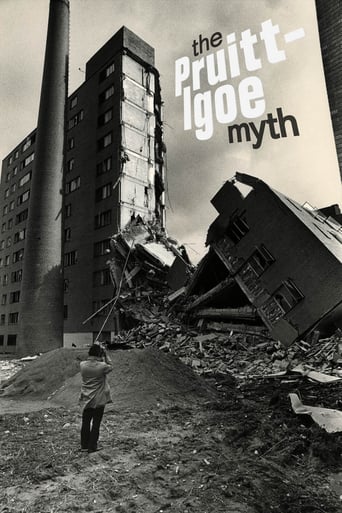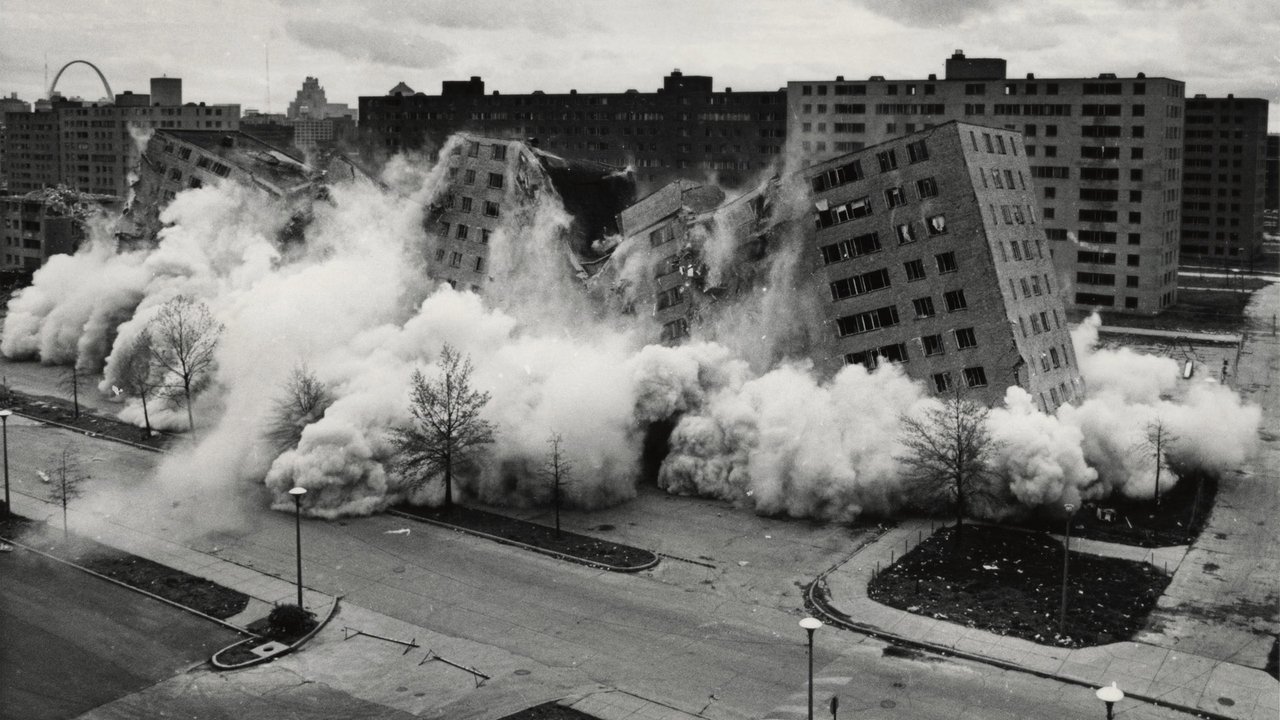MartinHafer
The Pruitt-Igoe housing development in St. Louis is the focus of this film, but it could have just as soon been Cabrini-Green in Chicago or any one of a number of similar projects across the American big cities. It's an exploration as to why these huge public housing projects became hellish instead of the paradises they were originally envisioned. Fortunately, the filmmakers don't pick any one or two simple answers but talk about the multitude of issues that led to the projects failing...and ultimately being demolished. Among the problems discussed in the film were the lack of jobs as businesses and middle classes migrated to the suburbs, the increase of violence and vandalism, lack of maintenance, segregation as well as the insane notion that in order to get public assistance that fathers could not remain in the home! This documentary is depressing and few folks would enjoy watching it. Now I am NOT saying it's bad and it's good for folks to become familiar with the issues that come up in the film. But it's just not the sort of thing most people would choose to watch and is probably more a film that educators might show to sociology or other such classes in order to explain the failures of these programs. Interesting and well made...despite it being such a terrible story.
ndelat3
*MAY CONTAIN SPOILERS*Urban planning is never static; things are constantly changing. It is the appreciation of why certain projects lead to complete failure and some succeed. The cliché "We learn about the past in order to learn about the future" is a very prominent theme embedded within this documentary. In some aspects, the Pruitt-Igoe Myth is more lament than examination. Through the survivors' tales of death both literal and figurative, Benjamin Balcom's dismal score portrays everything as it is out to be. Directed by Chad Freidrichs, this grim but powerful documentary covers the domestic turmoil by punitive public welfare policies and the processes of mass suburbanization that emptied American cities. The Pruitt-Igoe housing had high hopes but empty promises. This housing project created the dream of a wonderful life. Although it did assert the importance of community, it backfired in vandalism, vacancy, and crime. The film starts off with Solvester Brown, a former resident of Igoe-Pruitt, revisiting the area for the first time in over 30 years. The plot he went to was almost unrecognizable; it consisted of a vacant "mini-forest" surrounded by piles upon piles of junk and mounds of concrete. The movie then cuts to a housing project video advertising the project, promising indoor plumbing, electric lights and other things expected in the 20th century. The sight that Brown witnessed did not match the promise that the planners put forth. Post WWII and the beginning of the Cold War, the Pruitt-Igoe housing project was created in response to the national urban renewal process of the 50's/60's. St. Louis's urban renewal plan was one of the most ambitious. Having major influence for coalition due to their wealth and power, civic leaders and politicians viewed the slums as eyesores and the downtown area was of their full interest. Urban reformers pressed lawmakers to input new clean modern homes to re-energize depression-era housing projects installed by war. The 1949 Housing Act was installed to bulldoze the slums and incorporated 800,000 homes within the United States that were supposed to ensure safe and affordable mortgages to low-income communities. The federal government funded the production of the project but didn't put money into the maintenance. So slumlords took advantage of the distressed residents and played a part with the worsening conditions of the apartments. Slumlords would pack as many people as they could within these buildings because they knew these people were desperate. World War II took a toll on St. Louis's economy. From 1970 to 1980, the population had decreased by 28 percent, beating Cleveland's and Detroit's downfall. Post war, urban growth reversed. The cities were losing the working middle class, their industrial base, and overall investment. National suburbanization policies, or urban flight, was made possible by the same housing act for Pruitt-Igoe. The appeal of the suburbs became the mainstream, and many families sprawled to the newly developed areas outside the city in hopes for more opportunities and overall a better life. Due to the disinvestment to the city and increase demand for the suburbs, land tax decreased in urban areas and thus leading to less money for maintenance. The unfortunate lower class that was left behind within the slowly rotting public housing. As if it couldn't get worse, the welfare department mandated that families living within the housing project qualify for aid only if there is not an able bodied male present. Women and children were the only residents allowed to reside. Families had to sacrifice a father figure in order for everyone to have somewhere to sleep. Televisions and phones were also violations of receiving aid. These harsh regulations created even more isolation than the community of Pruitt-Igoe was already in. This sense of hopelessness and alienation created a sense of imprisonment that further made people products of their environment, consisting of vandalism and no sense of safety. In short, this figurative prison is the effects of the welfare The residents of Pruitt Igoe found themselves in a prison they could not escape because of their income restraints.Pruitt was essentially clean at first, but maintenance declined shortly. There was never an adequate provision for maintenance. Solvester Brown recalled scratch-proof elevators evolving into urine-smelling that did not operate. Brown and his brother would be stuck in an elevator all day and would eventually have to pry the doors open and climb rope from floor to floor. The slumlords did not have sufficient amount of money to fund the operations nor did the state of Missouri. A representative from the St. Louis Housing Authority was interviewed in regards to the lack of federal investment of operations within the housing and he claimed that they "simply do not have enough money to operate as well as we should". He in front of a poor incinerator with mounds of garbage piling up as he was making this statement. Although the Pruitt-Igoe had the stereotype of a bad, unsafe place, the adversities that the residents dealt with created a strong sense of community. Everyone knew everyone, they were never alone. The implosion was devastating because the project was the solution, and it was very painful moment of trust to see that failure. This documentary portrayed the Pruitt-Igoe housing project well in the aspect of that it was a symbol for failed public housing as well as the proceed failure of well intentioned government policies in general. This shines a light on the responsibility for not for just the urban planners but for the country to learn from those failures and do better.
amanz05
Like most documentaries that come out today, this asks the wrong questions and places blame in the wrong areas. I could go on forever but choose not to.I don't exactly know what the "myth" is in the documentary. Most of the blame looks like it is trying to be aimed at government, which is mostly wrong. This documentary is also dangerous (like most are) because it chooses only the information it wants to present. And I'm not saying that I know all of the facts, because I don't. But what people never do is look things up for themselves. they just take the information that is given to them on a platter and say , "oh, that's horrible. How can people do that?" etc...The real problems are never solved, and real questions are never asked. How did all of the windows break? Did the government do it? Why were things set on fire? Why did people urinate everywhere? Did the government come in and do that? Did the government come in and throw bottles at the policemen and firemen when they tried to put the fires out? I'm sure things were not like the grand ballroom at the housing complex, but who said it had to be? Tenants got mad when rent went up because people were leaving. Why did they leave? Not a hard question to answer. They should be going around yelling and protesting at each other for the rent going up because tenant's behavior caused people to leave which made rent rise. But lets blame society for poor planning and support.This needs to focus on one of the biggest problems facing society today, which is entitlement. It was bad then and it's only getting worse every day.
Chase McCants
The Pruitt-Igoe Myth is a documentary that tries to zero in on just why the massive public project went so quickly from being an modern masterpiece to an absolute hell in such a short amount of time. Architects, urban planers, sociologist, and politicians have all weighed in on why the housing project failed, but no one can pin point the exact problem. This documentary aims to step back from the project and look at the city of St. Louis as a whole. Urban Flight and the lack of jobs and support from the city are pointed to instead.The Pruitt-Igoe Myth means well. All too often, the reason for the project's demise is pointed to the poor that lived that. That they couldn't have nice things and keep up with them. The documentary, however, gives those people a voice. Throughout the film, people who lived in the community speak highly of their time there during what seemed to be golden years. Stories of love, union, and community run rampant. But that almost comes to the film's fault. We know whose side the film makers are on. And we only get the human story and not the other things that lead to the end. We aren't told about the skip-stop elevators, the condensing of physical space, or the fight for mixed housing. We hear a majority of human stories.Luckily, the interviewees paint a terrific and chilling picture of their experiences in the community. Even years later, a woman is brought to tears recounting how the people of the projects were viewed. Also a bonus are the massive amounts of pictures and videos looking back to a time we've all forgotten.The Pruitt-Igoe Myth is a great documentary that feels incomplete. Like having pancakes without bacon and eggs, what you get out of the movie is delicious...but you feel like you're missing something.


 AD
AD

